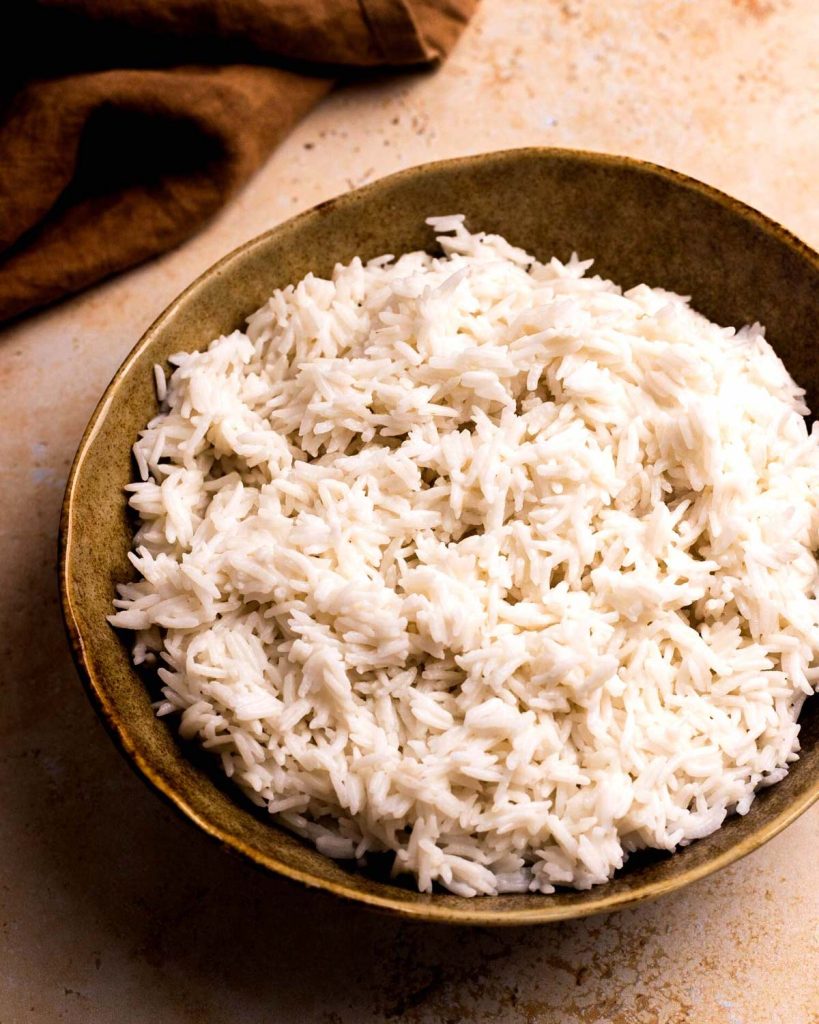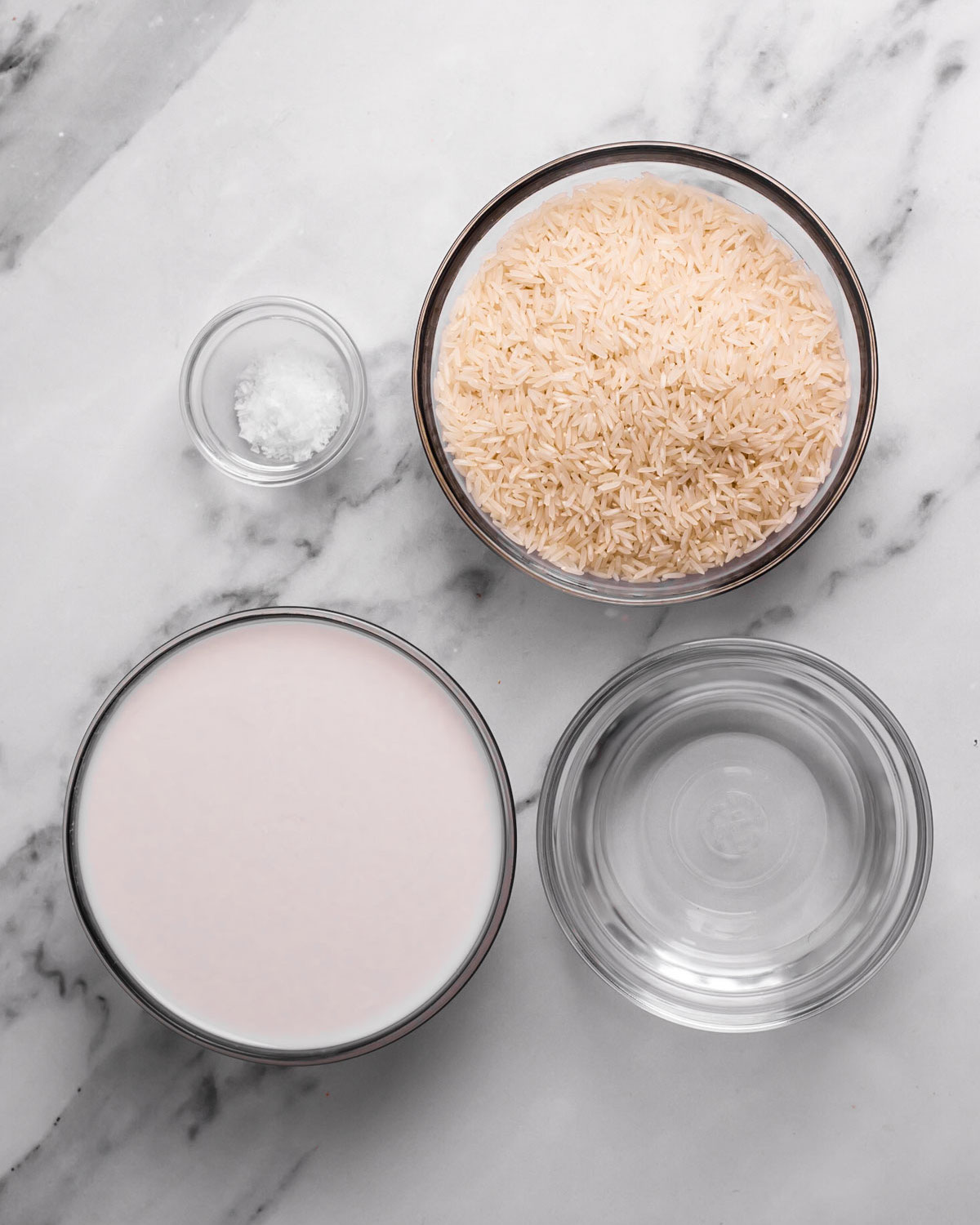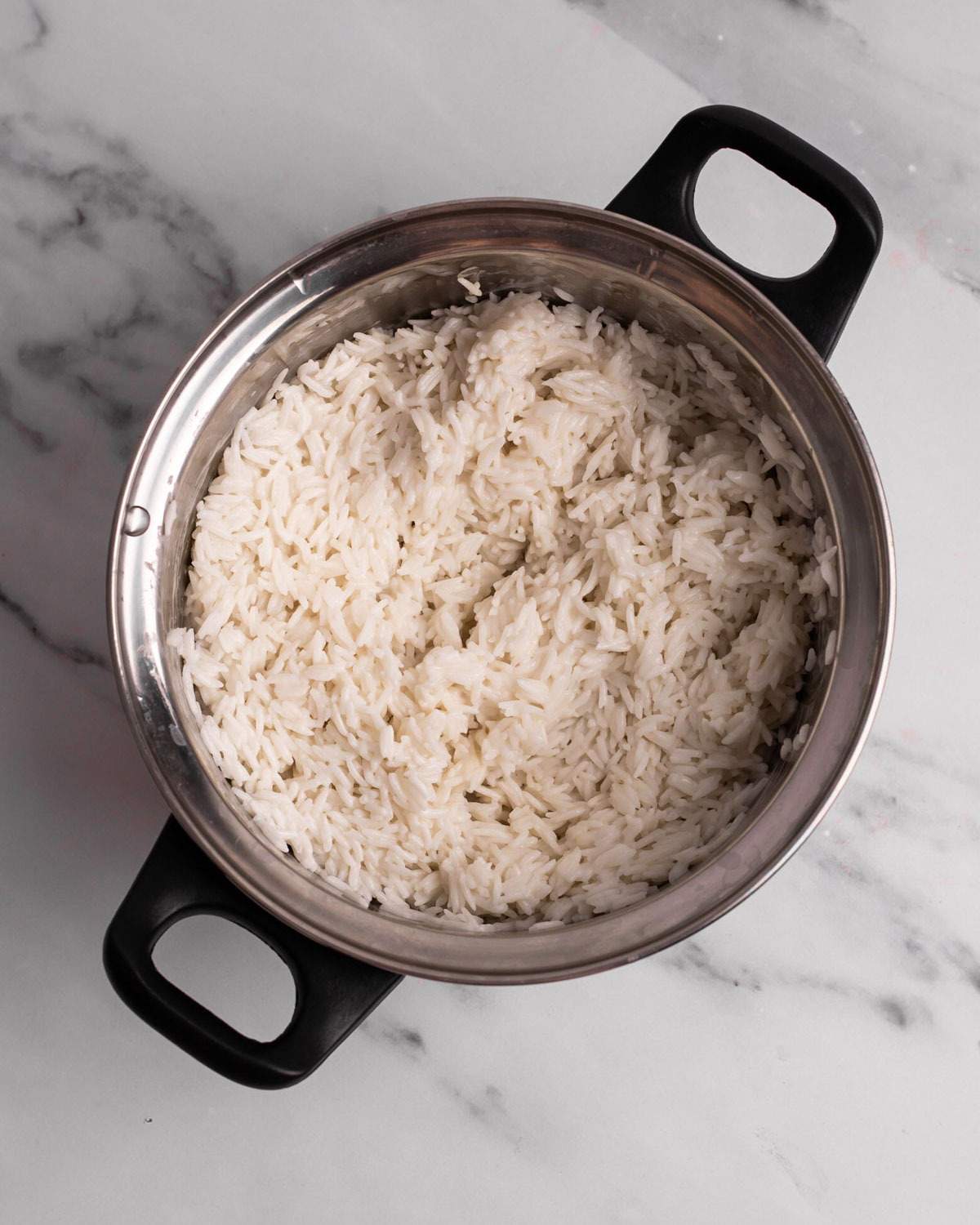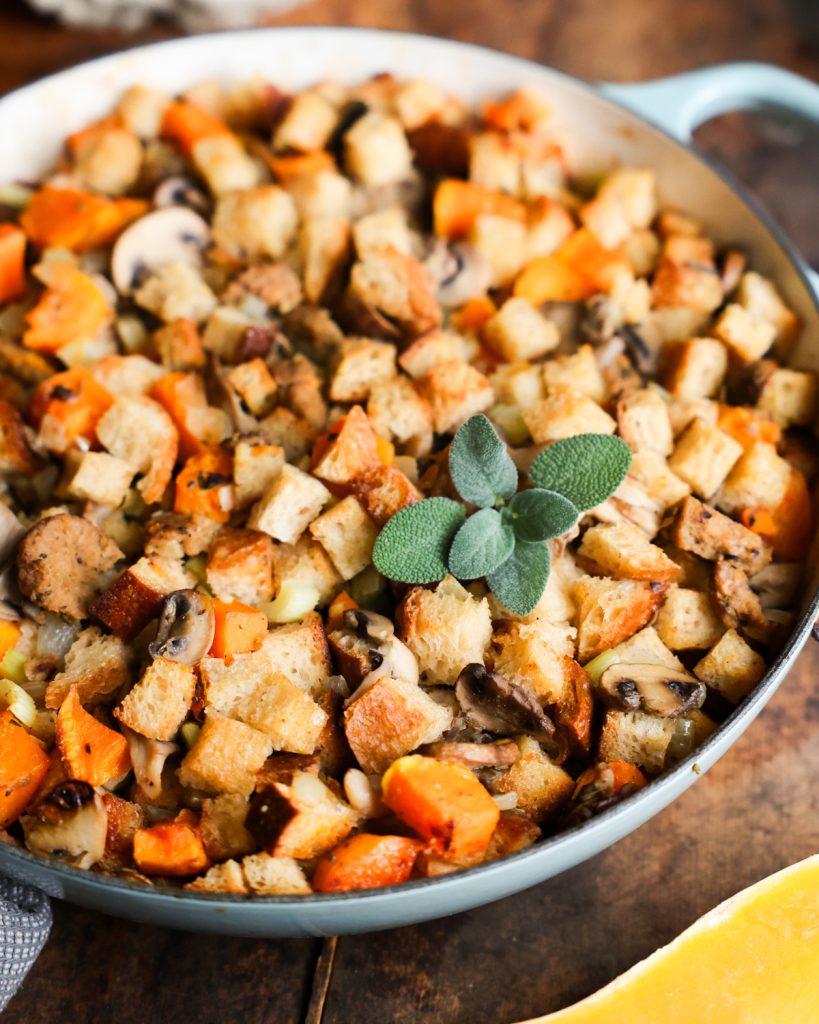
Elevate your meals with this luxurious Coconut Jasmine Rice recipe, made with four simple ingredients and ready in 20 minutes on the stovetop or 3 minutes in the Instant Pot! The fragrant, delicate aroma of jasmine rice combined with the creamy richness of coconut milk and a hint of sea salt makes an irresistible aromatic side dish. Pair it with your favorite mains or enjoy on its own!
If you’re looking for an easy-to-prepare side dish that bursts with flavor and pizzazz, you’ll adore this jasmine coconut rice recipe! Combining aromatic jasmine rice with rich, creamy coconut milk, results in a dish that will impress your taste buds and instantly enhance any meal. The delightful blend of nutty, sweet, and savory notes pairs wonderfully with a spicy curry, a savory stir-fry, or simply with veggies for a delicious light meal.
Thai coconut rice is perfect for busy weeknights, requiring minimal preparation while delivering a gourmet flavor that also makes it ideal for special occasions. This easy coconut rice recipe includes instructions for both stovetop and Instant Pot methods, allowing you to whip up this versatile staple however you please. Get ready to enjoy a dish that’s as simple to make as it is delicious!
For more flavorful vegan rice recipes, try my Instant Pot Mexican Rice, Roasted Cauliflower Rice, or Wild Rice Stuffed Sweet Potatoes.

Ingredients
Jasmine Rice: This long-grain rice is known for its subtle floral aroma and slightly sticky texture. Choose a high-quality jasmine rice for the best taste and texture. If desired, swap with brown jasmine rice for a nuttier flavor or another long-grain white rice. Keep in mind that cooking time, taste, and texture will vary.
Coconut Milk: Adds a rich, creamy texture and a hint of sweetness to the Thai jasmine rice recipe. Opt for full-fat canned coconut milk for maximum flavor and creaminess. Alternatively, use light coconut milk for a lighter dish or coconut cream for an even richer rice.
Water: Crucial for cooking the rice and providing the right consistency. Use 1 cup of water for stovetop cooking or ½ cup for Instant Pot preparation. Or, substitute vegetable broth or stock for added savory flavor.
Salt: A little salt goes a long way to enhance the flavors of the jasmine coconut rice. Use fine sea salt or kosher salt. For a different flavor profile, use garlic or onion salt.
How to Make Coconut Jasmine Rice
Thanks to two easy methods, it’s easy to prepare this versatile and delicious side dish. Read on to learn how to make the rice on the stovetop and in the Instant Pot.
Stovetop Directions
- Prepare Ingredients. Place all ingredients in a saucepan or pot. Stir well.

- Simmer. Bring the rice mixture to a simmer. Cook with the lid slightly ajar for 20 minutes, or until tender. Fluff the rice with a fork before serving.

Instant Pot Directions
- Prepare Ingredients. Place all ingredients into the Instant Pot. Secure the lid.
- Pressure Cook. Cook on high for 3 minutes. Then, naturally release the pressure before removing the lid. Fluff the rice with a fork before serving.

Recipe Pro-Tips
- Use high-quality ingredients. For the best flavor and texture, choose premium jasmine rice and full-fat coconut milk; it will make a noticeable difference in the result!
- Thoroughly rinse the rice. Rinse the rice under cold running water until the water runs clear to remove excess starch. This will help prevent the rice from becoming too sticky and ensure a fluffier texture.
- Shake the canned coconut well. Coconut milk often separates into cream and water in the can, so shake it well to reincorporate it before opening. This will help provide a consistent creamy texture throughout the coconut milk jasmine rice.
- Adjust the water ratio. Depending on your chosen cooking method, adjust the amount of water accordingly: use one cup for stovetop cooking, but reduce it to half of a cup for the Instant Pot to account for reduced evaporation.
- Don’t overcook. Watch the cooking time so the jasmine rice with coconut milk does not become mushy. If using the stovetop, keep the lid slightly ajar to allow some steam to escape so the rice cooks evenly without becoming too soft.
- Let it rest. After cooking, let the rice rest for a few minutes before fluffing and serving. This allows any excess moisture to be absorbed, enhancing the flavor and texture.
- Fluff with a fork. Once the rice has rested for a few minutes, fluff it gently with a fork rather than stirring with a spoon. This helps separate the grains and maintain a fluffy texture.
Recipe Mix-Ins
Below are a few suggestions for optional tasty mix-ins you can add to this jasmine rice with coconut milk recipe:
- Cilantro Lime: After fluffing the cooked rice, add 2 tablespoons of freshly chopped cilantro and 1 tablespoon of fresh lime juice.
- Spicy: For a spicy kick, add 1 finely chopped red chili or ½ teaspoon of red pepper flakes right before cooking the rice.
- Ginger: Before cooking, add 1 tablespoon of freshly grated ginger to the rice for a warm, aromatic flavor.
- Garlic: Sauté 2-3 minced garlic cloves in a little coconut oil before combining with the other ingredients for a rich, savory flavor.
- Turmeric: Add 1 teaspoon of ground turmeric to the rice before cooking to give the dish a vibrant yellow color and earthy flavor.
- Pineapple: Add 1 cup of diced fresh pineapple pieces after the rice has cooked for a tropical sweet jasmine rice.
Serving Suggestions
You can enjoy this dish on its own for a light snack, but what is coconut jasmine rice without a delicious main course to go with it?! This versatile side pairs well with a variety of foods like some of our favorite recipes below:

Storage Directions
- Refrigeration: Allow leftovers to cool completely before transferring to an airtight container and storing them in the refrigerator for up to 3-4 days.
- Freezing: Portion cooled rice into smaller freezer-safe containers or bags and freeze for up to 1-2 months. Thaw frozen rice in the refrigerator overnight before reheating.
- Reheating: Reheat refrigerated rice in the microwave or on the stovetop with a splash of water or coconut milk to restore moisture and prevent the rice from drying out.
More Vegan Side Dish Recipes
Recipe Card
Prevent your screen from going dark
Stovetop Instructions
-
Place all ingredients in a saucepan or pot. Stir well.
-
Bring the rice to a simmer. Cook with the lid slightly ajar for 20 minutes, until tender.
- Refrigeration: Allow leftovers to cool completely before transferring to an airtight container and storing them in the refrigerator for up to 3-4 days.
- Freezing: Portion cooled rice into smaller freezer-safe containers or bags and freeze for up to 1-2 months. Thaw frozen rice in the refrigerator overnight before reheating.
- Reheating: Reheat refrigerated rice in the microwave or on the stovetop with a splash of water or coconut milk to restore moisture and prevent the rice from drying out.
Recipe Pro-Tips
- Use high-quality ingredients. For the best flavor and texture, choose premium jasmine rice and full-fat coconut milk; it will make a noticeable difference in the result!
- Thoroughly rinse the rice. Rinse the rice under cold running water until the water runs clear to remove excess starch. This will help prevent the rice from becoming too sticky and ensure a fluffier texture.
- Shake the canned coconut well. Coconut milk often separates into cream and water in the can, so shake it well to reincorporate it before opening. This will help provide a consistent creamy texture throughout the coconut milk jasmine rice.
- Adjust the water ratio. Depending on your chosen cooking method, adjust the amount of water accordingly: use one cup for stovetop cooking, but reduce it to half of a cup for the Instant Pot to account for reduced evaporation.
- Don’t overcook. Watch the cooking time so the jasmine rice with coconut milk does not become mushy. If using the stovetop, keep the lid slightly ajar to allow some steam to escape so the rice cooks evenly without becoming too soft.
- Let it rest. After cooking, let the rice rest for a few minutes before fluffing and serving. This allows any excess moisture to be absorbed, enhancing the flavor and texture.
- Fluff with a fork. Once the rice has rested for a few minutes, fluff it gently with a fork rather than stirring with a spoon. This helps separate the grains and maintain a fluffy texture.


